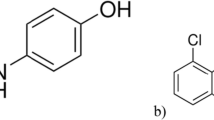Abstract
In this research, a novel composite is synthesized based on activated carbon and MIL-53(Al) through the solution mixing method at different MOF weight fractions, and the CO2 loading of prepared samples are measured in the batch and continuous apparatus. The structure, crystallinity, surface area, and chemical functionality of activated carbon, MIL-53(Al), and developed composite are characterized through BET, X-ray diffraction (XRD), scanning electron microscopy (SEM), and Fourier transform infrared spectroscopy (FTIR). The CO2 and N2 adsorption capacity of activated carbon, MIL-53(Al), and composites are examined in an isothermal batch reactor at the pressure range 0–110 kPa and equilibrium temperature 305 K. The adsorption isotherm of CO2 is correlated by the Langmuir and Toth models. Besides, the performance of composite is compared with MIL-53(Al) and activated carbon in a continuous packed bed at flow rate range 15–25 ml min−1 and temperature 32 °C, and the breakthrough curves are developed. The results show that increasing MOF content in the composite increases CO2 adsorption capacity, so the CO2 loading of synthesized composite containing 10%, 20%, and 30% MOF is 1.608, 1.704, and 1.792 mmol gr−1, respectively.









Similar content being viewed by others
Availability of data and materials
The datasets used in the current study are available from the corresponding author on reasonable request.
References
Ahmad A, Yasin NM, Derek C, Lim J (2011) Microalgae as a sustainable energy source for biodiesel production: a review. Renew Sust Energ Rev 15:584–593
Anbia M, Hoseini V (2012) Development of MWCNT@ MIL-101 hybrid composite with enhanced adsorption capacity for carbon dioxide. Chem Eng J 191:326–330
Andonova S, Ivanova E, Yang J, Hadjiivanov K (2017) Adsorption forms of CO2 on MIL-53(Al) and MIL-53(Al)–OHx as revealed by FTIR spectroscopy. J Phys Chem 121:18665–18673
Camacho BC, Ribeiro RP, Esteves IA, Mota JP (2015) Adsorption equilibrium of carbon dioxide and nitrogen on the MIL-53 (Al) metal-organic framework. Sep Purif Technol 141:150–159
Concas A, Pisu M, Cao G (2014) Current environmental issues and challenges. Springer
Couck S, Gobechiya E, Kirschhock CE, Serra-Crespo P, Juan-Alcañiz J, Martinez Joaristi A, Stavitski E, Gascon J, Kapteijn F, Baron GV (2012) Adsorption and separation of light gases on an amino-functionalized metal–organic framework: an adsorption and in situ XRD study. ChemSusChem 5:740–750
Do DD (1998) Adsorption analysis: equilibria and kinetics. Imperial College Press, London
Jiao Y, Li Z, Ma Y, Zhou G, Wang S, Lu G (2017) The studies on gas adsorption properties of MIL-53 series MOFs materials. AIP Adv 7(085009):1–8
Kayal S, Chakraborty A (2018) Activated carbon (Type Maxsorb-III) and MIL-101(Cr) metal organic framework based composite adsorbent for higher CH4 storage and CO2 capture. Chem Eng J 334:780–788
Loiseau T, Serre C, Huguenard C, Fink G, Taulelle F, Henry M, Bataille T, Ferey G (2004) A rationale for the large breathing of the porous aluminum terephthalate (MIL-53) upon hydration. Chem Eur J 10:1373–1382
Mishra P, Uppara HP, Mandal B, Gumma S (2014) Adsorption and separation of carbon dioxide using MIL-53 (Al) metal-organic framework. Ind Eng Chem Res 53:19747–19753
Mounfield WP III, Walton KS (2015) Effect of synthesis solvent on the breathing behavior of MIL-53 (Al). J Colloid Interface Sci 447:33–39
Sreńscek-Nazzal J, Narkiewicz U, Morawski AW, Wróbel RJ, Michalkiewicz B (2015) Comparison of optimized isotherm models and error functions for carbon dioxide adsorption on activated carbon. J Chem Eng Data 60(11):3148–3158
Patterson A (1939) The Scherrer formula for X-ray particle size determination. Phys Rev 56:978–986
Przepiórski JM, Skrodzewicz A, Morawski W (2004) High-temperature ammonia treatment of activated carbon for enhancement of CO2 adsorption. Appl Surf Sci 225:235–242
Rahimpour MR, Farsi M, Makarem MA (2020) Advances in carbon capture: methods, technologies, and applications. Woodhead Publishing
Regufe MJ, Ferreira AF, Loureiro JM, Rodrigues A, Ribeiro AM (2019) Electrical conductive 3D-printed monolith adsorbent for CO2 capture. Microporous Mesoporous Mater 278:403–413
Shahkarami S (2017) CO2 capture from gases using activated carbon. University of Saskatchewan
Shen C, Grande CA, Li P, Yu J, Rodrigues AE (2010) Adsorption equilibria and kinetics of CO2 and N2 on activated carbon beads. Chem Eng J 160:398–407
Author information
Authors and Affiliations
Contributions
Mohammad Farsi: conceptualization; Mohammad Farsi and Peyman Keshavarz: funding acquisition, supervision, and data curation; Mohammad Farsi, Peyman Keshavarz, and Sedighe Zeinali: formal analysis and validation; Arman Soleimanpour: methodology; and Mohammad Farsi and Arman Soleimanpour: visualization, writing, and editing.
Corresponding author
Ethics declarations
Ethical approval
It is confirmed that the submitted manuscript is original, clear, and unique and has not been published elsewhere in any form or language. Besides, it has been not submitted to other journals and simultaneous consideration.
Consent to participate
Not applicable.
Consent to publish
Not applicable.
Competing interests
The problems and environmental issues related to carbon dioxide emissions have persuaded us to focus on the carbon dioxide separation from the gas mixtures. It seems carbon capture and carbon dioxide conversion will be one of the main human challenges in the next. Currently, the corresponding author has been focused on the carbon capture and designing the feasible and economic processes to convert carbon dioxide to valuable products.
Additional information
Responsible Editor: Tito Roberto Cadaval Jr
Publisher’s note
Springer Nature remains neutral with regard to jurisdictional claims in published maps and institutional affiliations.
Rights and permissions
About this article
Cite this article
Soleimanpour, A., Farsi, M., Keshavarz, P. et al. Modification of activated carbon by MIL-53(Al) MOF to develop a composite framework adsorbent for CO2 capturing. Environ Sci Pollut Res 28, 37929–37939 (2021). https://doi.org/10.1007/s11356-021-13382-y
Received:
Accepted:
Published:
Issue Date:
DOI: https://doi.org/10.1007/s11356-021-13382-y




